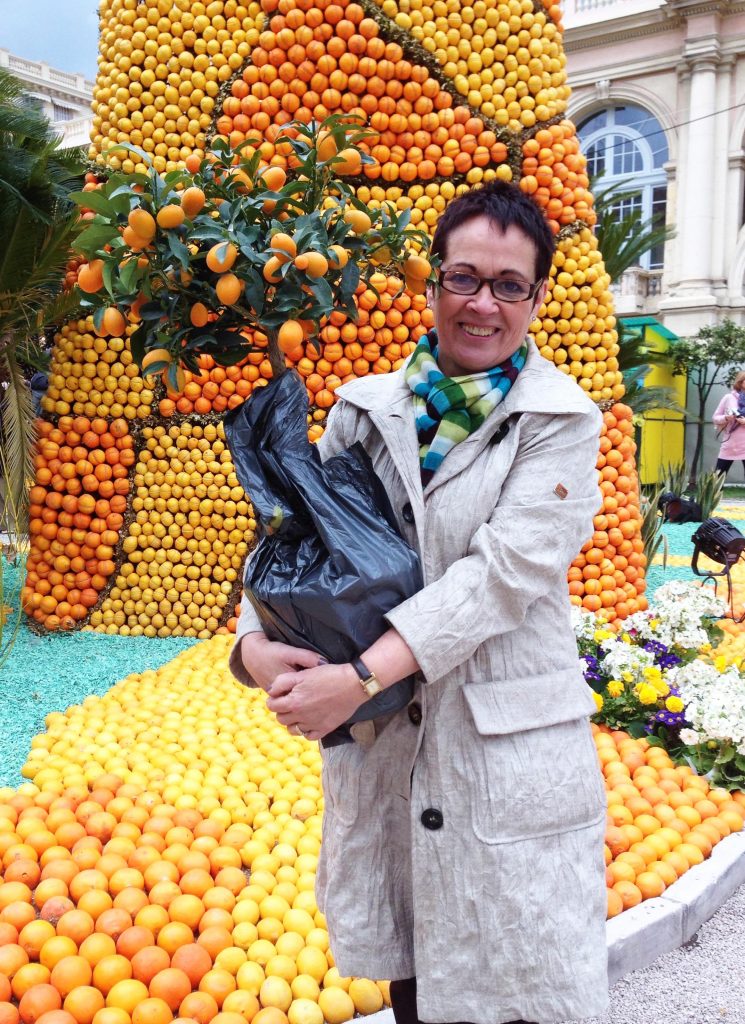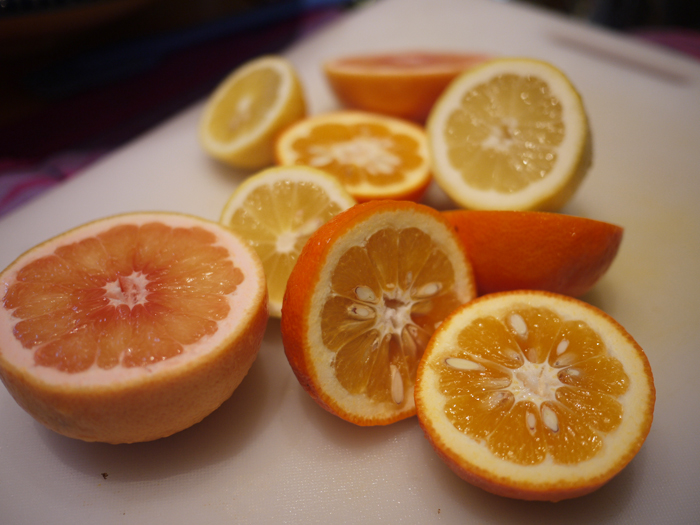One of the joys of Twitter is meeting like-minded preservers of fruit and vegetables. During a trip to Italy last year I met Jennifer Barnaby @GustiaFood and discovered our mutual love of citrus fruit. In Jennifer’s peaceful garden in Menton, orange, lemon and kumquat trees produce abundant harvests during the 
winter months. Kumquats, I see rarely, for sale in Somerset, although I’ve ordered them from wholesale markets at a premium price.
Hardly surprising, I jumped at an invitation to go to Menton at the beginning of March to make marmalades with fresh fruit picked from Jennifer’s trees.
Fête du Citron
My stay coincided with a Fête du Citron in Menton, a celebration of citrus fruit. Since the 15th century, Menton has a history of growing lemons and the first festival was held in 1929. Using an estimated 145 tonnes of fruit, to create spectacular visual displays, the festival lasts for two weeks and attracts thousands of visitors.
Each year, the festival has a theme, this year Jules Verne 20,000 Leagues Under the Sea. Giant designs and statues of vessels, sea life and even Captain Nemo made from oranges and lemons greeted us as we entered the Biovès Gardens during the first afternoon in Menton. The sheer scale of the displays was breathtaking. Around the perimeter, stalls selling citrus themed crafts and kumquat trees, the fruit on the trees, larger than I am used to seeing.
 We were drawn to one tree in particular, destined for Jennifer’s garden.The tree needed a name, so we asked for one via Twitter. Some great names were suggested, but in the end we liked “Lady Marmalade” one from Vanessa Kimbell.
We were drawn to one tree in particular, destined for Jennifer’s garden.The tree needed a name, so we asked for one via Twitter. Some great names were suggested, but in the end we liked “Lady Marmalade” one from Vanessa Kimbell.
The Fruit
Kumquats make a great marmalade on their own or mixed with lemons. They take a while to prepare, dissecting the inner membranes, separating the fruit, pips and slicing the peel; it helps to have a friend to help. Once prepared the fruit was left for an overnight soak in water.
The Marmalades
We made four Marmalades made over the weekend; Kumquat, Three Fruit ( Bitter Orange, Grapefruit and Lemon), Lemon and Lavender and Bitter Orange.I was most curious to try the Bitter Orange. I’m used to Seville oranges, having made marmalade with them for years. Would these bitter oranges produce a marmalade with a similar flavour? The fruit looked similar, brightly coloured, firm skins, pippy and not too juicy. The fruit had been ripe on the trees for three months. Would time have made a difference to the flavour? The marmalade we made was sweet, but we thought this was due to a faulty muslin bag. When I got home, I made the marmalade again and the flavour was similar to Seville orange. We used the same recipe and brand of sugar, Tate & Lyle granulated cane sugar. I had packed 5kg of this sugar intending to recreate the marmalade recipes I made at home. An unusual item of luggage but a sugar I cannot do without when making sweet preserves. The Lemon and Lavender and the Kumquat Marmalades had fantastic flavours but the sets were a little slack. The Three Fruit had the best set and flavour. Here’s the recipe.
Makes approx 2.25kg
1 small grapefruit
2 lemons
2 small sweet or bitter oranges
1.4kg (3lb) granulated, cane sugar
1.75 litres (3 pints) water.
1.Juice the fruit, with a combined weight of 675-700g and pour the juice with the water into a large, lidded pan with a capacity of 6-8 litres. Scrape out the inner membranes and pips from the fruit with a small sharp knife. Leave the pith on the fruit
2. Put the membranes into a food processor or mini-chopper and chop finely. Put the chopped membranes, and any pips into a 30 cm x 30cm piece of thin cotton muslin. Tie this up with string and add it to the pan. Shred the peel and add it to the pan; finely shredded peel releases the maximum amount of pectin. If possible, leave the pan overnight to allow the fruit to soak.
3. Next day, bring the lidded pan to boil, turn down the heat and simmer very gently for two hours. The peel should be very tender, and the contents of the pan reduced by a third. Warm the sugar in a low oven, 140℃ /275℉/Gas 1
4. Remove the lid from the pan and set aside. Lift up the muslin bag and squeeze the liquid from the bag back into the pan through a sieve, using a large spoon.
5. Add the sugar to the pan and stir until dissolved. Gradually bring the pan to a rolling boil and test for a set after 7 minutes, using the flake test. Dip a large spoon into the pan and scoop out a spoonful. Lift the spoon above the pan and turn it horizontally. If the marmalade has reached setting point of 104.5℃ ( 220℉) it will drip then hang on the side of the spoon.
6 Leave the marmalade to cool for 5-10 minutes, a skin should have formed on the surface. Remove any scum from the surface with a large metal spoon.
7. Pour the marmalade into clean, warm sterilised jars and cover with new twist top lids. Alternatively, seal the jars with waxed discs and when cold, apply cellophane covers secured with elastic bands. Leave the jars upright and undisturbed to set.
Links
Images of fruit by Jennifer Barnaby Gustia
Three Fruit Marmalade image by Robert Walster
Fête du Citron
Vanessa Kimbell of Kitchen Garden School
For more recipes First Preserves: Marmalades – eBook, or First Preserves: Marmalades – Jams – Chutneys
